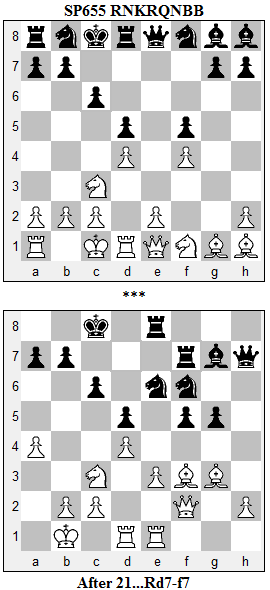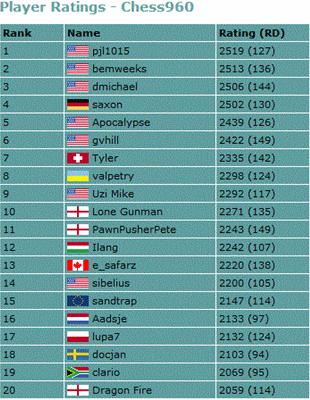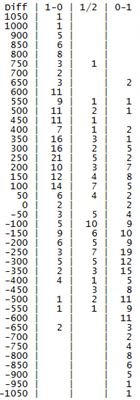CCRL means "Computer Chess Rating Lists". We are a club of people inspired by watching computers play chess.
While I'm not at all 'inspired by watching computers play chess', I do accept that the CCRL findings are the single most important collection of chess960 games in existence today. I ended the 'Revisited' post by concluding that the CCRL sample at that time was probably too small to make generalizations. The club now boasts of having played 115.900 games of chess960, or an average of more than 115 games per start position, or 3-4 times more games than at the time of my first post.
How do the current CCRL statistics compare with that first analysis? Here is a table similar to my earlier table. As before, it shows the number of games played (#); the percentage of games won by White, won by Black, and drawn (%W, %B, %D); and the overall score for White (%S).
| SP | FEN | # | %W | %B | %D | %S |
|---|---|---|---|---|---|---|
| Highest Overall Score White | ||||||
| 408 | RBQNBNKR | 112 | 57.1 | 29.5 | 13.4 | 63.8 |
| 868 | QBBRKRNN | 120 | 54.2 | 26.6 | 19.2 | 63.8 |
| 749 | RKNBNQBR | 116 | 52.6 | 25.8 | 21.6 | 63.4 |
| 730 | RKNQBBNR | 114 | 55.3 | 28.9 | 15.8 | 63.2 |
| 376 | NBRKBRNQ | 140 | 56.4 | 30.6 | 12.9 | 62.9 |
| Highest Overall Score Black | ||||||
| 465 | BRNBNKRQ | 106 | 34.0 | 50.0 | 16.0 | 42.0 |
| 786 | BRQKNBRN | 114 | 30.7 | 47.3 | 21.9 | 41.7 |
| 888 | RBQKBRNN | 118 | 27.1 | 44.1 | 28.8 | 41.5 |
| 499 | BRQNKNRB | 118 | 29.7 | 49.1 | 21.2 | 40.3 |
| 067 | BNNRKQRB | 116 | 28.5 | 49.1 | 22.4 | 39.7 |
| Traditional Start | ||||||
| 518 | RNBQKBNR | 135 | 44.4 | 34.8 | 20.7 | 54.8 |
| Traditional Start (K&Q switched) | ||||||
| 534 | RNBKQBNR | 84 | 34.5 | 35.7 | 29.8 | 49.4 |
The first observation is that the 'the overall score for White (%S)' lies in a narrower range than before: 64%-42% now vs. 76%-32% earlier. The second observation is that of the top five percentages for White, only one start position is on both lists (SP868 QBBRKRNN); of the bottom five percentages for White (i.e. top five for Black), the list is completely different. The third observation is that the traditional start position (SP518 RNBQKBNR) is now in line with experience.
On the earlier list, I examined the top position for White (SP024 NBQNBRKR) in A Followup, an Error, and an Insight, and surmised (with the help of another chess960 enthusiast) that 'the dangerous start positions share the common feature of several Pawns unprotected and these can be easily attacked by the Queen and Bishop'. That is clearly the case for SP868, where the 'QBB' on the a/b/c-files rake the 'RNN' f/g/h-files. For the record, SP024 is now no.12 on the list, with a 60.9% success rate for White rather than the 76.2% in the earlier table. It's worth remembering that the CCRL requires both 'Book learning' and 'Position learning' to be 'Off for all engines'. This means that the engines don't improve by playing more games.
Now here's a big, yellow WARNING FLAG: the no.1 and the no.3 entries in the current table (SP408 RBQNBNKR & SP749 RKNBNQBR) are twins -- they have the same sequence of pieces, but in reverse order -- only the castling considerations are different. These two positions, plus the repeat position SP868, need to be examined more closely. I would also like to identify the other top (and bottom) twins to determine how random their CCRL results are. I'll follow-up these actions in future posts.


 I loaded the PGN header info into a database and did some simple calculations. Of the 560 games, there were 488 with ratings for both players. I couldn't think of a clever way to present the data graphically, so I just produced the table shown on the left.
I loaded the PGN header info into a database and did some simple calculations. Of the 560 games, there were 488 with ratings for both players. I couldn't think of a clever way to present the data graphically, so I just produced the table shown on the left.
